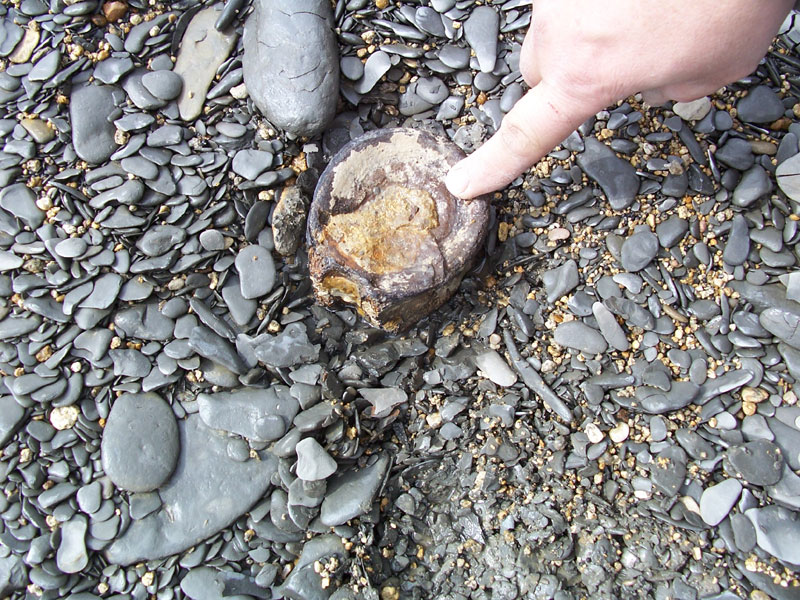I dont know if i mentioned it but they look like fish vertebra
could be ichthyosaur... they are very large too, however
chthyosaurs averaged about two to four metres (6 to 13 ft) in length.
Some individual specimens were as short as 0.3 metres (1 ft); some species were much larger: the Triassic Shonisaurus popularis was about 15 metres (49 ft) long and in 2004 Shonisaurus sikanniensis (sometimes classified as a Shastasaurus sikanniensis) was estimated to have been 21 metres (69 ft) in length.[59] Fragmentary finds suggest the presence of a 15 metres (49 ft) long form in the Early Jurassic.[60] According to weight estimates by Ryosuke Motani a 2.4-meter (8 ft) Stenopterygius weighed around 163–168 kilograms (359–370 lb), whilst a 4-meter (13 ft) Ophthalmosaurus icenicus weighed 930–950 kilograms (2,050–2,090 lb).
General build
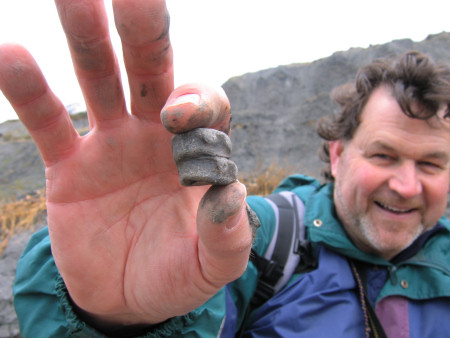
lyme regis is the UK...
shark
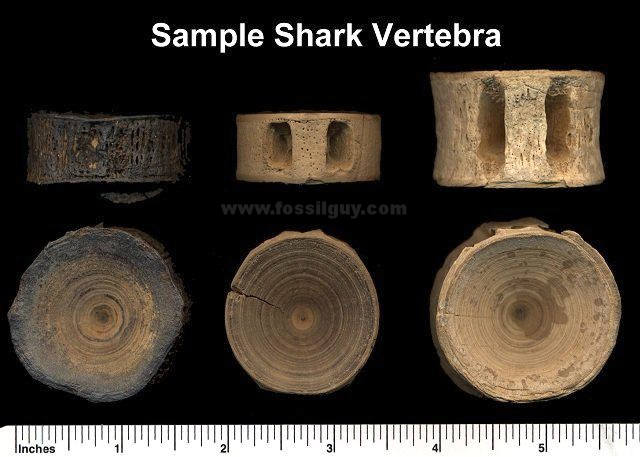
shark dolphin tarpin
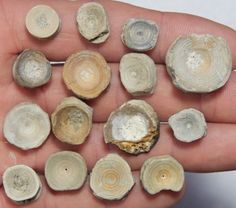
- 22390f0d7f5ecfd9fe851d3351fe8412.jpg (10.51 KiB) Viewed 697 times
Shark
The opalised gastroliths of freshwater crayfish are known locally as 'yabby buttons.'
Crayfish use gastroliths to store calcium from their exoskeletons ('shells') ...
they exist in australia
yabby buttons
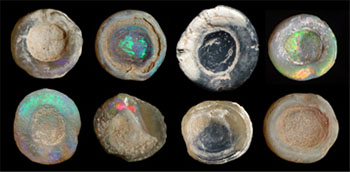
- gastroliths.jpg (45.85 KiB) Viewed 697 times
American museum of natural history
Identification Day
Saturday, May 6, 2017Inspired by the legacy of Theodore Roosevelt, the Museum celebrates natural history collections by inviting visitors to bring in their own specimens to the annual Identification Day. Scientists will attempt to identify your discoveries while showing you rarely seen specimens from the Museum's collections.
nice thing about such days is that once in a while they find something for the collection.

The Museum’s collection of more than 33 million specimens includes modern animals and ancient fossils, including naturally mummified specimens like Effie the mammoth, on view in the Hall of Advanced Mammals.
the reason i say this is that
if this is super rare, it will be misclassified. for instance... if its one of a kind, a new species, etc... which it can be...
then on top with the opal? the average is going to glance at it, and give the answer they learned or everyone says!
i have seen this 'accident' a lot of times...
funny thing is, there is nothing stopping you from getting a 25c print of the images at the pharmacy
and putting a stamp in an envelope with a SASE (self addressed stamped envelope) inside for a response
and dont be surprised you get an answer as the whole thing is paid for by you, and they only have to write short and slap it in the envelope
i have done it more than a dozen times in my life... while its not 100%, you do get responses more often than not if your polite and they are not swamped (meaning lesser museum might do it when THE natural museum doesnt. but the truth is, they think of such thing as justifying their existence beyond just look at this stuff)

5 Awesome Things Identified at AMNH's Annual ID Day
http://mentalfloss.com/article/63820/5- ... rys-id-dayFor the past 26 years, the American Museum of Natural History has been inviting visitors to bring the unidentified objects discovered in backyards, attics, and the great outdoors to an event called Identification Day, which this year is happening this Saturday, May 9. “ID Day stemmed from in-house scientists receiving many inquiries from the public throughout the year wanting to have their mysterious objects and artifacts identified,” says Dominic Davis, Public Programs Coordinator in the museum’s Department of Education. “The hope is to highlight the numerous scientific departments and research currently being done at the Museum. This is also a wonderful opportunity for scientists to interact with the public and share rarely seen collections.”
On average, 2500 people visit the museum on ID Day, and the staff identifies more than 150 objects. (They won’t perform a valuation, though—this isn’t Antiques Roadshow!) Those who have an object identified get a certificate and the opportunity to take a photo with the museum’s bronze Theodore Roosevelt bust.
Of course, not everything brought to the museum on ID Day is a home run. “We often have people bring in what they think are arrowheads or a meteorite but they’re simply rocks,” Davis says. “We see artifacts that are quite old but were mass produced for retail use. The list is endless and might not be what people hope, but the anticipation is always exciting.”
Carl Mehling, Senior Scientific Assistant in the museum’s Division of Paleontology, says the museum’s experts “have disappointed a number of visitors by setting them straight on several misidentified treasures—like fake trilobite fossils from Morocco, carved ivory made of plastic, and the inevitable ‘dinosaur egg’ that turns out to be an egg-shaped rock.” (His favorite misidentification, he says, “was a visitor who brought in what she thought was a bedbug, but it turned out—thankfully!—to be a live shiny spider beetle, Gibbium aequinoctiale.”)
The threat of disappointment shouldn’t discourage anyone from bringing their unidentified objects to ID Day, though—they might, like the people below, have something truly extraordinary on their hands.
1. A FOSSILIZED WALRUS SKULL
Kit Kennedy found this specimen on the beach in Virginia and brought it to the museum for identification, and in 2000, she donated it. The specimen has to be a fossil, because modern walruses are strictly Arctic animals. According to Mehling, the species is likely Odobenus rosmarus—the same as the modern walrus. “But there may not even be enough there to ID it to species; it is just the front of a skull,” he says. “Its age is likely Pleistocene, but as it was found free of its geological context, we can’t be certain. But since it is so modern-looking, and I don’t think there were others to confuse it with—there's no good reason to consider it anything else. Based on similar fossils, [walruses, at that time,] ranged at least as far south as North Carolina.”
2. A STONE HAND AXE
Museum experts put this axe, which was discovered in the backyard of a Staten Island resident, at a minimum of 3000 years old. “Depending on the type of hand ax they can come from a period known as the Archaic some 2000 to 8000 years BP,” says Anibal Rodriguez, an associate in Anthropology who has participated in ID Day for a number of years. The axe, likely made of basalt, was used for crushing and chopping. There’s no way to know who might have made it—according to Rodriguez, there were “too many tribes in the area to know for sure.”
3. A 100 MILLION YEAR OLD BRAZILIAN FISH FOSSIL
This fossil turned up in the backyard of a New Jersey home in 2002. And if you’re wondering, How did a fossil of a Brazilian fish end up in a backyard in New Jersey?, you’re not alone—but Mehling says the answer is an easy one. “Fossils go wherever people go and have been for thousands of years,” he says. “This one, however, is most likely a fossil that someone purchased in the 20th century and then lost.”
4. PIECES OF 17TH CENTURY BRICKS
OK, so pieces of bricks might not seem that interesting—until you think about where, and when, they came from. Back in the 17th and 18th centuries, ships would leave port with their cargo holds weighted with ballast, which kept them steady in rough seas. Ballast could be anything from dirt to—you guessed it!—bricks, which they’d unload at their destination to make room for their cargo before taking off again. In 2013, a museum visitor brought a bag of shells and other beach drift from Trinidad’s Maracas beach to ID Day. In the drift were pieces of colonial bricks, some of them yellow—which would indicate they came from the Netherlands, more than 4500 miles away.
5. AN AMERICAN PELICANSFOOT
Despite what the name might imply, this specimen is actually a sea snail, not a bird. (They kind of look like a pelican’s foot, though, which probably explains the name.) These animals live in deep water and their shells hardly ever wash up on shore, so the shell that a visitor brought to ID Day in 2012, which belonged to an almost full-grown juvenile, was an especially good find.
If you’re thinking about bringing an item to ID Day, watch the helpful video below—which includes guidelines about what you’re allowed to bring—to prepare.
